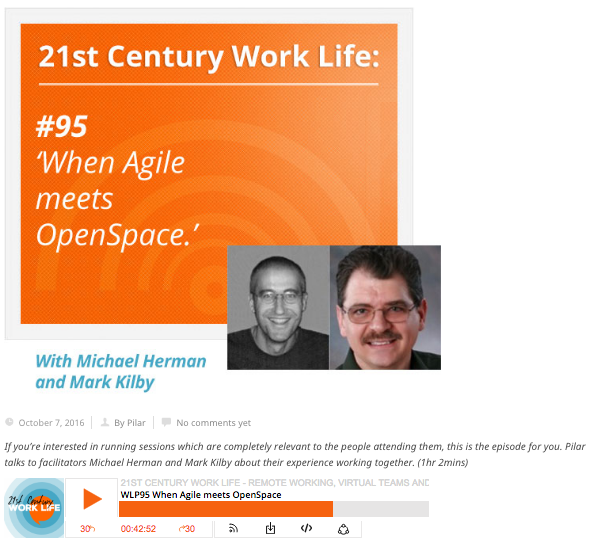still thinking about something i posted to the OSLIST a while back.
…some years ago, at one of our chicago open space trainings, a music therapist friend (louise mitran), brought a couple cases of music-making things. in a session she convened, we tried to make and sustain “chaos,” a state of no rhythmic pattern. we found it pretty much impossible. so i think maybe why we don’t see it happening in open space is that it is so fleeting. it’s just changes happening, being made, shapes shifting and then new patterns emerging so quickly that we notice the new, enduring patterns and it’s pretty much impossible to notice, much less sustain, any “chaos.”
thinking about a spectrum from chaos to control, my first guess was that chaos and not-caring were somehow connected to the same end of the spectrum, opposite to control. today i’m thinking that not-caring IS what makes control possible, and maybe even necessary. a wandering philosopher of sorts once told me that totalitarian dictatorship required three conditions: widespread apathy, control of the media (story), and generalized insecurity. open space works to directly undercut all three.
as often as not, i think, as more people step up and express more active caring, those “in control” can relax (unless being in control of others is their main intent). managerial ease happens long before real chaos shows up. and chaos probably never shows up, because no captain or crew members, excepting the sociopathic few, want it to go there.
the balance between caring and control would seem to be a sort of self-balancing thing, like the number of breakouts and size of the large meeting room in open space. that is, the more breakouts we have, the smaller they get, the closer people sit, the quieter they can be… so the room size can be pretty much the same, and hold more or fewer breakouts. if the room can hold 100 people, it will work no matter how many ways the group divides. as passion increases, responsibility increases, managerial control can decrease. as less caring and attentiveness allow breakdown, those who
still care must work harder to hold things together, to maintain control.
i guess the far end is that too much caring, everybody cares, is where stalemates and conflicts emerge, spats, fights, even wars. but then there’s also the question of WHAT it is that everyone is caring about. this is why purpose matters. this is why we convene open space around the future of the company rather than something like “what are the issues and opportunities for raising your (own) pay, reducing your workload, and improving your benefits package.”
so maybe the dance is really between individual caring and organized control, and the thing that holds it all together is our continual reach for the biggest possible theme, question and organizational “self.”
as i recall, the only way to (almost by chance) sustain any sort of chaos in that musical exercise, i think, was to actively NOT listen to any others and concentrate fully on my own (noise).
this morning, coming out of a two-day open space in jakarta, indonesia, i’m understanding it this way…
it’s not that control is better than chaos, or vice versa. no more that passion is better than responsibility or learning better than contribution. nor questions better than answers. they’re all akin to breathing out and breathing in. it’s not that working in open space is better than traditional managing, planning and conferencing methods. (and in the context of our work with USAID here in jakarta this week, not that american way is better than indonesian way of development.)
it’s the going back and forth that strengthens us, in the realization that complete chaos and total control are equally untenable, unsustainable, impermanent. so the one will always nudge us, gently or firmly, back in the direction of the other. self-organization is the inescapable play between these two ends of everything and open space doesn’t oppose formal organization, it depends on and supports it, and vice versa.
the more we practice backing and forthing between the two, our work in open space can handle all kinds of technical, analytical, conflicted, complex decision-making challenges and the results get more measurable, far beyond mere “brainstorming,” while traditional management and planning work can become more adaptive, flexible, inviting and engaging. it’s the going back and forth that strengthens our organizations and communities.
putting this in terms of the inviting organization story, this is the backing and forthing between what matters on the inside and what can be observed and constructed on the outside, and also personal caring and action as processed through organizational culture and process. in this going back and forth, all “techniques” become part of a larger body, called practice.

